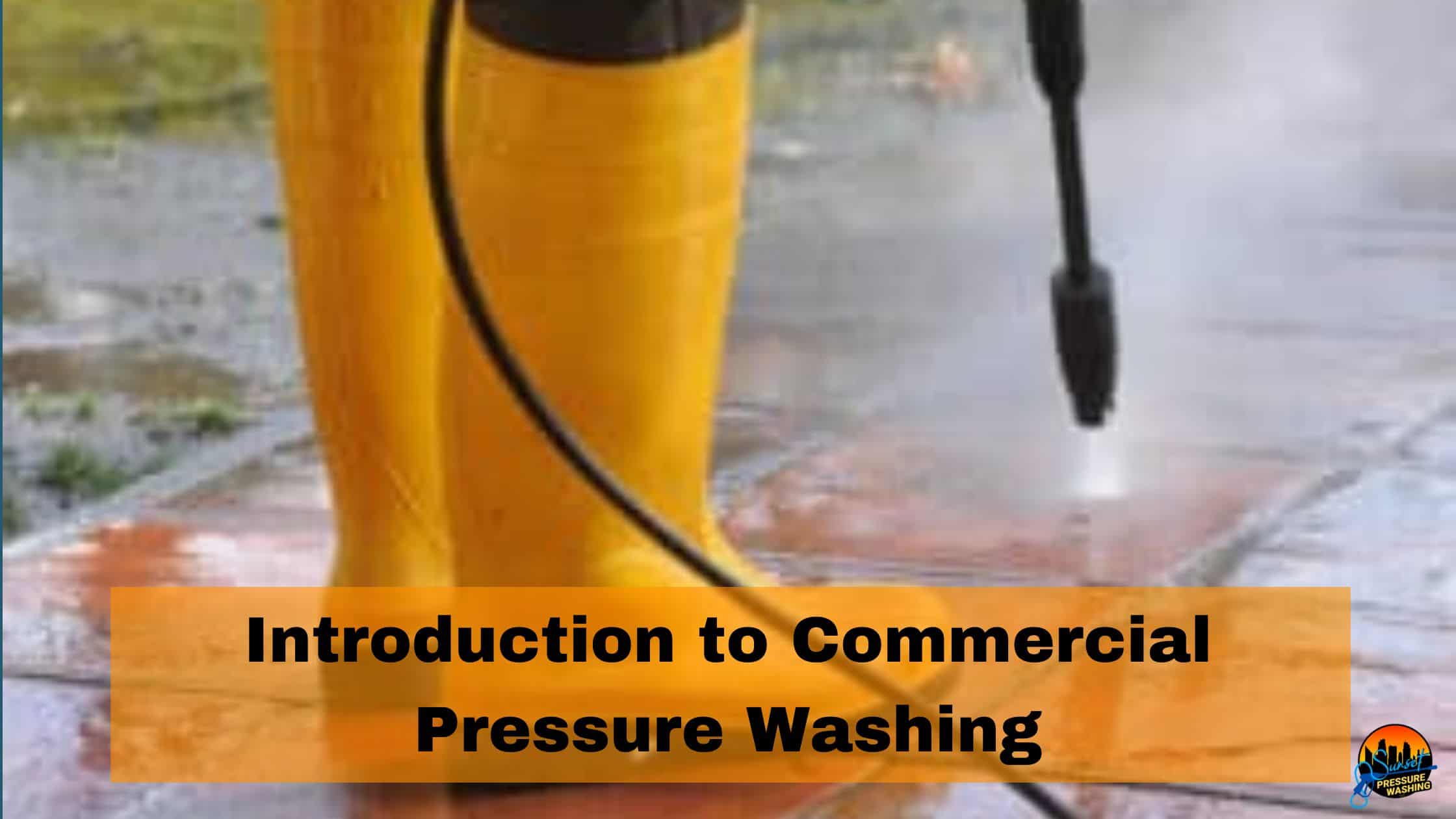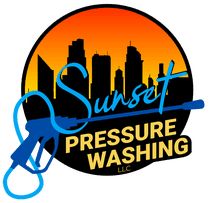
Introduction to Commercial Pressure Washing
Commercial pressure washing is a powerful cleaning method used across various industries to maintain buildings, vehicles, and equipment. It involves the use of high-pressure water spray to remove dirt, grime, mold, mud, and other types of debris from surfaces and objects. In this comprehensive guide, we’ll explore the world of commercial pressure washing, its benefits, techniques, applications, and much more.
Understanding Pressure Washing
Pressure washing, also known as power washing, is a highly efficient method used to clean various types of surfaces and objects. It involves the use of a high-pressure water spray, which is significantly more powerful than a regular hose. This method is particularly effective in removing stubborn dirt, grime, mold, loose paint, mud, and other debris. To fully grasp the concept of pressure washing, it’s essential to understand its core components and how they function together.
Essentially, a pressure washer includes a motor-powered high-pressure water pump, a hose, and a trigger-operated gun. The power of these machines is measured in PSI (pounds per square inch) for pressure, and GPM (gallons per minute) for the flow of water. Residential models typically range from 1,200 to 2,800 PSI, suitable for most home cleaning tasks.
While both pressure washing and power washing use high-pressure water, power washing often involves heated water for more intense cleaning. For most residential purposes, however, standard pressure washing with cold water suffices, offering an efficient and eco-friendly way to maintain and clean exterior surfaces.
Core Components of a Pressure Washer
- Pressure Washer Unit: This is the heart of the operation. It consists of a motor (either electric or gasoline-powered) that powers a water pump.
- Water Pump: The pump is the mechanism that pressurizes the water and controls the flow through the nozzle.
- High-Pressure Hose: This specialized hose is designed to withstand the high pressure of the water that flows through it.
- Nozzle: The nozzle at the end of the hose controls the spray pattern and intensity. Different types of nozzles are used for different cleaning tasks.
How Pressure Washing Works
Pressure washing works by using a high-velocity water jet to blast away dirt and other materials from surfaces. The pressure is measured in pounds per square inch (PSI), and the volume of water used is measured in gallons per minute (GPM). Higher PSI means more power for removing tough substances, while a higher GPM allows for covering larger areas more quickly.
Cold Water vs. Hot Water Pressure Washing
Pressure washers can also be categorized based on the temperature of the water they use:
- Cold Water Pressure Washers: Most common and are excellent for general cleaning tasks. They are more portable and easier to operate.
- Hot Water Pressure Washers: More effective in removing grease, oil, and other stubborn substances. The hot water helps to break down the dirt, making it easier to clean. These are often used in industrial or agricultural settings.
Pressure Washing Chemicals
In some cases, water alone might not be sufficient. Pressure washing can be combined with cleaning agents or chemicals to enhance the cleaning process. These chemicals are specially formulated to be used at high pressures and are effective in tackling specific types of dirt or stains.
Types of Pressure Washing Equipment
Pressure washing is a versatile cleaning method that requires the right equipment to be effective and efficient. The type of pressure washer you choose should be based on the specific cleaning tasks you have in mind. In this section, we’ll explore the various types of pressure washing equipment available, helping you understand their features and applications.
1. Electric Pressure Washers
- Description: Electric pressure washers are powered by electricity and are known for their convenience and ease of use. They are typically smaller, lighter, and quieter than their gasoline counterparts, making them ideal for residential use.
- Best For: Light to medium-duty tasks such as cleaning cars, motorcycles, outdoor furniture, grills, patios, and small decks.
- Advantages: Environmentally friendly, low maintenance, easy to start, and can be used indoors due to the absence of exhaust fumes.
2. Gasoline Pressure Washers
- Description: Gasoline pressure washers are powered by gasoline engines and are more powerful than electric models. They are portable and not limited by the length of a power cord, offering greater freedom of movement.
- Best For: Heavy-duty tasks such as cleaning large decks, sidewalks, driveways, exterior siding, and commercial applications.
- Advantages: More power, mobility, and suitable for larger and tougher cleaning jobs.
3. Hot Water Pressure Washers
- Description: Hot water pressure washers are capable of heating water, providing an added advantage in cleaning. The hot water not only helps to clean more effectively but also sanitizes surfaces.
- Best For: Industrial applications, grease and oil removal, and cleaning surfaces with stubborn stains.
- Advantages: More effective in removing tough grease and grime, faster cleaning, and sanitization capabilities.
4. Cold Water Pressure Washers
- Description: Cold water pressure washers are the most common type and use water at ambient temperature. They are simpler in design and more straightforward to use than hot water models.
- Best For: General cleaning tasks like removing dirt, mud, and sand from surfaces.
- Advantages: More affordable, lightweight, and easier to operate and maintain compared to hot water pressure washers.
5. Stationary Pressure Washers
- Description: Stationary pressure washers are fixed in one location and are designed for repeated use in the same place. They are often found in commercial and industrial settings.
- Best For: Factories, workshops, or any place where cleaning is frequently required in a specific area.
- Advantages: Durability, can be connected to fixed water and power sources, and are ideal for high-usage environments.
6. Portable Pressure Washers
- Description: Portable pressure washers are designed for mobility and can be easily transported to different locations. They vary in size and power and can be either electric or gasoline-powered.
- Best For: On-the-go cleaning needs, such as mobile detailing services or construction sites.
- Advantages: Mobility, flexibility in usage, and suitable for areas without easy access to power or water sources.
7. Professional-Grade Pressure Washers
- Description: Professional-grade pressure washers are built for durability and performance. They are designed for daily, intensive use and have higher PSI and GPM (gallons per minute) ratings.
- Best For: Commercial cleaning businesses, large-scale pressure washing projects, and regular heavy-duty use.
- Advantages: High power, durability, and designed for long hours of operation.
The Science Behind Pressure Washing
Pressure washing, a widely used method for cleaning surfaces, is more than just spraying water at high pressure. It involves a fascinating interplay of physics and chemistry. Understanding the science behind pressure washing can help you use it more effectively and safely. Here we delve into the mechanics and principles that make pressure washing work.
1. The Role of Pressure
- Physics of Pressure: Pressure washing operates on the basic principle of mechanics – Force applied over an area. Measured in pounds per square inch (PSI), the pressure is what gives water its power to break the bond between the dirt and the surface.
- Impact of High Pressure: High-pressure streams create a forceful impact on the surface, dislodging dirt, grime, and other substances. This is particularly effective for hard, non-porous surfaces.
2. Water Flow Rate (GPM)
- Gallons Per Minute (GPM): Along with pressure, the flow rate of water, measured in gallons per minute, plays a crucial role. It determines the quantity of water used, impacting how effectively the loosened debris is washed away.
- Balance of PSI and GPM: A balance between PSI and GPM is necessary for efficient cleaning. High GPM can compensate for lower PSI, and vice versa, depending on the cleaning task.
3. Heat: The Power of Hot Water Pressure Washing
- Thermal Energy: Hot water pressure washers use heat to enhance cleaning efficiency. Heat increases the kinetic energy of water molecules, helping to break down dirt and grease more effectively.
- Chemical Reactions: Heat can also accelerate chemical reactions, making cleaning agents more effective. This is especially useful for oily or greasy stains.
4. Cleaning Agents in Pressure Washing
- Chemical Assistance: For certain tasks, water alone might not suffice. Detergents or cleaning agents can be introduced into the water stream to tackle specific cleaning challenges.
- Surface Tension Reduction: Cleaning agents reduce the surface tension of water, allowing it to penetrate and dissolve dirt more effectively. This is particularly important for porous surfaces.
5. The Importance of Nozzle Types
- Pressure Concentration: Different nozzles concentrate water pressure in various patterns (e.g., fan, jet). The choice of nozzle affects the cleaning efficiency and the type of surfaces that can be cleaned.
- Angle and Spread: Nozzles also determine the angle and spread of the water stream. A narrower angle means higher pressure concentration, suitable for tougher stains.
6. Mechanical Action
- Erosion and Displacement: The mechanical action of a high-pressure water stream can be likened to a very fast, targeted erosion process. It displaces and removes particles from the surface.
- Cavitation: In some high-pressure applications, the rapid change in pressure can create cavitation bubbles in the water, which can help in dislodging dirt.
Safety First: Pressure Washing Safety Tips
Using a pressure washer efficiently and safely requires adherence to certain safety guidelines. This is essential to prevent accidents and injuries, considering the high pressure and power involved in pressure washing. Here are some vital safety tips for anyone using a pressure washer.
Read the Manual
Understanding your equipment is crucial before operating a pressure washer. Make sure to thoroughly read the manufacturer’s manual, familiarize yourself with the controls, proper usage, and safety features of the machine.
Wear Protective Gear
Always wear goggles or safety glasses to protect your eyes from flying debris. Since pressure washers can be loud, especially gasoline-powered models, it’s important to use ear protection to safeguard your hearing. Wear long pants and sturdy, closed-toe shoes to protect your skin from high-pressure water and debris, and avoid loose clothing that can get caught in the equipment.
Be Aware of Your Surroundings
Before starting, it’s essential to clear the area of people, pets, and unnecessary objects. Be especially cautious of children and animals who may unexpectedly enter the area. Also, be aware of slippery surfaces, both for yourself and others, as water and cleaning solutions can create slippery conditions.
Handle High Pressure with Care
Never underestimate the force of the water stream from a pressure washer. It can cause serious injuries and damage surfaces if not used properly. It’s critical to never direct the pressure washer at yourself, other people, or animals, as the high-pressure stream can cause severe injuries.
Electrical Safety
For electric pressure washers, ensure that all electrical connections are safe and use a ground fault circuit interrupter (GFCI) plug. Keep the electrical cord and the water supply separate to avoid the risk of electric shock.
Use Chemicals Safely
If you’re using detergents or chemicals, follow the manufacturer’s instructions for safe handling. Wear gloves and, if necessary, a mask to avoid inhaling fumes.
Properly Connect and Use Attachments
Ensure that all hoses, nozzles, and attachments are securely connected before starting the pressure washer. A loose nozzle or hose can become a dangerous projectile under high pressure.
Be Cautious with Gasoline
If using a gasoline-powered pressure washer, handle and store fuel safely. Refuel in a well-ventilated area, ensure the engine is cool, and avoid any spills.
Avoid Ladder Use
Using a pressure washer while on a ladder can be dangerous due to the recoil of the wand. Instead, use extension wands or attachments for reaching high places.
Turn Off and Depressurize
After use, it’s important to turn off the pressure washer and squeeze the trigger to release any remaining pressure. Follow the manufacturer’s instructions for proper shutdown and storage.
Pressure Washing Techniques
Mastering various pressure washing techniques is essential for efficient and effective cleaning. Different surfaces and types of dirt require specific approaches. Understanding these techniques will not only improve cleaning results but also help in preserving the integrity of the surfaces being cleaned. Here’s an overview of key pressure washing techniques:
Understanding Pressure and Nozzle Types
Choosing the right pressure level and nozzle type is crucial. Different nozzles are designed to deliver water streams at various angles, affecting the intensity and coverage area of the spray. For example, a 0-degree nozzle produces a narrow, powerful stream for tough stains, while a wider-angle nozzle is better for delicate surfaces.
Soft Washing
Soft washing is a low-pressure cleaning technique, typically used on surfaces that can be damaged by high pressure, like roof shingles or delicate woodwork. It often involves the use of specialized cleaning solutions to break down dirt and organisms like mold and algae, which are then gently washed away.
Hot Water Pressure Washing
This technique involves using hot water in the pressure washer. The heat helps to effectively break down oily and greasy substances, making it ideal for industrial or commercial environments where these types of stains are common. It’s also effective in sanitizing surfaces.
Cold Water Pressure Washing
Cold water pressure washing is the most common method and is suitable for a wide range of applications. It’s effective for removing dirt, mud, and sand, and is typically more energy-efficient and easier to manage than hot water pressure washing.
Detergent Use
For certain cleaning tasks, water alone might not be sufficient. Adding detergents or cleaning agents can enhance the cleaning process, especially for stubborn stains or specific cleaning requirements. It’s important to use detergents designed for pressure washers and to rinse the surface thoroughly after application.
Surface-Specific Techniques
Different surfaces require different approaches. For example, wood surfaces need a lower pressure to avoid damage, while concrete can withstand higher pressures. It’s important to research or consult guidelines for the specific surface you’re cleaning.
Streak-Free Washing
To avoid streaks, especially on large flat surfaces like driveways, it’s important to use a consistent technique. Start from the top or one end and work systematically, overlapping each stroke slightly to ensure even cleaning.
Pre-Treatment and Post-Treatment
For optimal results, surfaces may need pre-treatment with a cleaning solution before pressure washing. Similarly, post-treatment can involve applying sealants or protectants, particularly for surfaces like wood or concrete, to extend the cleaning benefits and protect against future dirt and damage.
Regular Maintenance Washing
Regular, light pressure washing can prevent the buildup of dirt and grime, making it easier to keep surfaces clean over time. This is especially beneficial for commercial and public spaces that require consistent cleanliness.
Environmentally Friendly Practices
Be conscious of the environmental impact of pressure washing. This includes being mindful of water usage, choosing eco-friendly detergents, and ensuring runoff does not contain harmful chemicals that can contaminate water sources.
Common Applications of Commercial Pressure Washing
Commercial pressure washing is an indispensable tool in maintaining the cleanliness and appearance of various business environments. Its versatility and efficiency make it ideal for a wide range of applications, ensuring that commercial properties not only look their best but also offer a safe and welcoming environment for customers and employees.
Building Exteriors
Pressure washing is highly effective for cleaning the exteriors of buildings, including various materials like brick, stucco, and siding. It’s excellent for removing dirt, bird droppings, and environmental pollutants, which can mar a building’s appearance. Also, it plays a crucial role in graffiti removal, restoring the building’s facade to its original state.
Parking Lots and Driveways
In parking lots and driveways, pressure washing is used to remove oil spills, tire marks, and other stains that accumulate over time. Regular cleaning of these areas not only improves their appearance but also prevents the buildup of substances that can deteriorate the surface.
Sidewalks and Walkways
For sidewalks and walkways, pressure washing is essential for removing gum, stains, and mildew, which helps in maintaining their appearance and safety. It also aids in restoring sidewalks to their near-original color and texture, enhancing the overall aesthetic of the area.
Commercial Vehicles and Equipment
Commercial vehicles like trucks, buses, and vans, as well as heavy machinery used in construction or agriculture, benefit greatly from pressure washing. It’s an efficient way to keep these vehicles clean, which is important for maintenance, branding, and the longevity of the equipment.
Outdoor Dining Areas and Patios
Restaurants with outdoor dining areas greatly benefit from regular pressure washing to maintain hygiene and a pleasant dining environment. It effectively removes food stains, spills, and bird droppings, ensuring a clean and inviting space for customers.
Public Spaces and Facilities
High-traffic areas such as playgrounds, parks, and stadiums require regular cleaning to ensure they remain clean, safe, and inviting. Pressure washing these areas is an effective way to maintain these standards.
Industrial Cleaning
In industrial settings like factories and warehouses, pressure washing is vital for cleaning floors, walls, and loading docks. It efficiently removes industrial stains, grease, and grime, contributing to a safer and cleaner work environment.
Storefronts and Commercial Windows
For retail businesses, clean storefronts and windows are key to attracting customers. Pressure washing helps in removing dirt and streaks, enhancing the visibility and appeal of the store.
Dumpster Areas
Areas around dumpsters can quickly become dirty and develop unpleasant odors. Pressure washing these areas is important for sanitation, hygiene, and odor control.
Roofs and Gutters
Maintaining roofs and gutters is also a critical application of pressure washing. It removes debris, algae, and moss that can cause water damage and deterioration, extending the longevity of these structures.
Eco-Friendly Pressure Washing Practices
In recent years, the focus on environmentally friendly practices has extended to all areas of maintenance and cleaning, including pressure washing. Adopting eco-friendly methods not only helps in reducing the environmental impact but also often results in more efficient and cost-effective operations. Here’s how businesses and individuals can incorporate green practices into their pressure washing activities.
Use of Biodegradable Cleaning Agents
The choice of cleaning agents plays a significant role in eco-friendly pressure washing. Opting for biodegradable detergents minimizes the impact on the environment. These cleaners break down more quickly and do not leave harmful residues. It’s important to select products that are specifically designed to be safe for the environment.
Water Conservation Techniques
Water conservation is a key aspect of eco-friendly pressure washing. Using modern, efficient pressure washers can help reduce water usage as they are designed to maximize cleaning power while minimizing water waste. Techniques like recapturing and recycling the water used in pressure washing are also becoming increasingly popular.
Energy Efficiency
Energy efficiency is another important consideration. Electric pressure washers generally have a smaller carbon footprint than gasoline-powered ones. If a gasoline-powered washer is necessary, it’s advisable to choose models that are fuel-efficient and have lower emissions.
Proper Disposal of Waste Water
The runoff from pressure washing can contain pollutants like oil, grease, and chemicals. It’s crucial to prevent this waste water from entering storm drains or natural water bodies. Methods for proper disposal include using containment systems to collect and dispose of the water safely, or implementing water treatment systems to remove contaminants before disposal.
Minimizing Chemical Use
Whenever possible, reducing the quantity of chemicals used in pressure washing is encouraged. Often, high-pressure water alone can be effective for many cleaning tasks. When chemicals are necessary, it’s important to use them sparingly and only as much as needed.
Training and Best Practices
Proper training in eco-friendly pressure washing techniques is vital. Operators should be educated on the best practices for minimizing environmental impact, including the right way to handle detergents, how to avoid water wastage, and the importance of maintaining equipment to ensure optimal efficiency.
Regular Maintenance of Equipment
Well-maintained equipment not only performs better but is also more efficient. Regular maintenance ensures that pressure washers operate at peak efficiency, reducing energy and water consumption. This includes checking for leaks, ensuring optimal settings, and replacing parts that may reduce efficiency.
Noise Reduction
Noise pollution is another environmental concern. Using equipment that operates with less noise helps in reducing the sound pollution, especially in residential areas and during early or late hours.
Compliance with Local Environmental Regulations
Staying informed and compliant with local environmental regulations is essential. Different regions may have specific guidelines on water usage, chemical use, and waste water disposal. Adhering to these regulations ensures that pressure washing activities are not only eco-friendly but also legally compliant.
Choosing a Professional Pressure Washing Service
When it comes to tackling large, complex, or particularly challenging cleaning tasks, hiring a professional pressure washing service can be a wise decision. Professional services bring expertise, the right equipment, and an understanding of eco-friendly practices that ensure a thorough and safe cleaning. However, choosing the right service requires careful consideration. Here are key factors to consider when selecting a professional pressure washing company:
Experience and Reputation
Experience is crucial in pressure washing, as it often determines the quality of the service. Look for a company with a solid track record and good reputation. Check online reviews, ask for references, and consider how long the company has been in business. A reputable company should have a portfolio of past projects and satisfied clients.
Licensing and Insurance
Ensure that the pressure washing service is licensed and insured. Licensing shows that they are officially recognized and adhere to industry standards. Insurance is critical to protect your property from accidental damage and to cover any potential injuries that could occur on your property during the service.
Equipment and Techniques
A professional service should have state-of-the-art equipment and be knowledgeable about the latest pressure washing techniques. This includes having a range of pressure washers, nozzles, and cleaning solutions to cater to different types of cleaning tasks. Inquire about their methods and whether they use eco-friendly cleaning agents.
Customized Services
Look for a company that offers customized cleaning solutions. Different surfaces and types of dirt require different approaches. A good pressure washing service will assess your specific needs and suggest a tailored approach rather than a one-size-fits-all solution.
Eco-Friendly Options
As environmental concerns continue to grow, it’s important to choose a service that uses eco-friendly practices. This includes the use of biodegradable detergents, water conservation methods, and waste water management. Ask the company about their environmental policies and practices.
Cost and Value
While cost is a factor, it shouldn’t be the only consideration. Seek out competitive quotes, but also consider the value being offered. The cheapest option may not always provide the best quality or reliability. A professional service that may charge a bit more but guarantees high-quality work and has good insurance coverage could offer better value in the long run.
Customer Service
Good customer service is indicative of a company’s professionalism. Pay attention to how they handle your inquiries, whether they provide clear and detailed information, and if they are willing to address any concerns you have. Professionalism in customer service often reflects the overall quality of their work.
Timeframe and Flexibility
Consider the company’s availability and their ability to work within your timeframe. Flexibility is important, especially if you need the work done urgently or outside of regular business hours.
Safety Protocols
A professional pressure washing service should prioritize safety. This includes following safety protocols, training their staff properly, and using equipment safely. Ask about their safety practices to ensure they take this aspect seriously.
DIY Tips for Small Businesses
For small business owners, managing expenses is crucial, and sometimes that means taking on tasks like pressure washing in-house. Doing it yourself can be cost-effective and rewarding, provided it’s done safely and efficiently. Here are some essential DIY tips for small businesses considering pressure washing:
Regular Inspection
Regularly inspect your pressure washer for any signs of wear and tear. Check hoses for cracks or leaks, nozzles for blockages, and look for any loose connections. A routine inspection can help you catch and address small issues before they turn into bigger problems.
Cleaning After Use
After each use, it’s important to thoroughly clean the pressure washer. Flush out any detergent or cleaning agents from the system. This helps prevent corrosion or buildup that can clog your washer or damage its components.
Proper Storage
Store your pressure washer in a clean, dry place to prevent rust and deterioration. If you’re storing it in a place with freezing temperatures, make sure to winterize it by draining all the water out of the machine to prevent freezing and cracking.
Hose Maintenance
The hose is one of the most important components of a pressure washer. Regularly check for any kinks, leaks, or wear. Store the hose properly by coiling it without twisting to avoid damage.
Check and Replace Filters
Most pressure washers have filters that prevent debris from entering the pump. Clean these filters regularly and replace them if they are worn out or damaged to ensure smooth operation and to protect the pump.
Engine and Pump Care
For gasoline-powered pressure washers, regular engine maintenance is crucial. This includes checking oil levels, cleaning or replacing air filters, and ensuring the spark plug is in good condition. For the pump, use pump conditioner or lubricant as recommended by the manufacturer.
Nozzle Care
Nozzles can become clogged with dirt or debris, which can affect the pressure washer’s performance. Clean the nozzles regularly using a needle or similar tool to remove any blockages.
Monitor Pressure Settings
Regularly check the pressure settings to ensure they are aligned with the type of cleaning job you are doing. Using excessively high pressure can wear out your equipment faster.
Keep Spare Parts Handy
Having spare parts like O-rings, hoses, and nozzles on hand can be convenient for quick replacements. This ensures that you can continue your work with minimal downtime.
Why Choose Sunset Pressure Washing for Your Needs
Choosing Sunset Pressure Washing for your commercial pressure washing services means selecting a partner dedicated to exceptional cleanliness and maintenance. Our expertise not only enhances the aesthetic appeal of your property but also ensures a safe and welcoming environment for all. For a comprehensive solution to your cleaning needs, trusting Sunset Pressure Washing is a step towards maintaining excellence in your commercial space.
With a focus on quality, reliability, and customer satisfaction, we are equipped to handle the unique challenges of maintaining commercial properties. Their commitment to using the latest technology and eco-friendly methods ensures that your property is not only clean but also protected. Explore the full range of services and the difference Sunset Pressure Washing can make for your commercial space by visiting our website.






